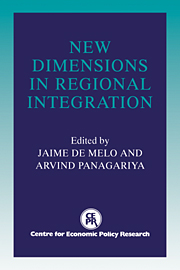Book contents
- Frontmatter
- Contents
- List of figures
- List of tables
- Preface
- Foreword
- Acknowledgements
- List of conference participants
- PART ONE SYSTEMIC ISSUES
- PART TWO COUNTRY ISSUES
- 6 The new regionalism: a country perspective
- Discussion
- 7 The European Community: a case of successful integration?
- Discussion
- 8 Regional integration in Sub-Saharan Africa: past experience and future prospects
- Discussion
- 9 Latin America's integration and the multilateral trading system
- Discussion
- 10 Regional integration in Eastern Europe: prospects for integration within the region and with the European Community
- Discussion
- 11 Regional trade arrangements in North America: CUSTA and NAFTA
- Discussion
- 12 Trading blocs and East Asia
- Discussion
- 13 Prospects for regional integration in the Middle East
- Discussion
- Round Table Discussion
- Index
Discussion
Published online by Cambridge University Press: 04 May 2010
- Frontmatter
- Contents
- List of figures
- List of tables
- Preface
- Foreword
- Acknowledgements
- List of conference participants
- PART ONE SYSTEMIC ISSUES
- PART TWO COUNTRY ISSUES
- 6 The new regionalism: a country perspective
- Discussion
- 7 The European Community: a case of successful integration?
- Discussion
- 8 Regional integration in Sub-Saharan Africa: past experience and future prospects
- Discussion
- 9 Latin America's integration and the multilateral trading system
- Discussion
- 10 Regional integration in Eastern Europe: prospects for integration within the region and with the European Community
- Discussion
- 11 Regional trade arrangements in North America: CUSTA and NAFTA
- Discussion
- 12 Trading blocs and East Asia
- Discussion
- 13 Prospects for regional integration in the Middle East
- Discussion
- Round Table Discussion
- Index
Summary
Chapter 7 is a useful survey of the history of EC integration and the issues to which it gives rise. I want to pick up on Winters’ argument where he leaves it in section 4.4 – that is, the interaction between integration in the movement of goods and factors, and other instruments of policy such as taxes and regulations. Winters rightly identifies two views on these. One is that after integration, competition over rules and policies, e.g., over tax rates or over environmental and other regulations, will resolve any problems and will in fact lead to convergence of policies. The second view is that supranational intervention is needed to regulate this competition – for example, through explicit harmonisation of policies.
I want to evaluate these two views using a framework that Keen and I have developed for looking at tax competition between countries that differ in economic size (1991), and which he, Sweder van Wijnbergen and I have applied to environmental regulation competition (1992). In such a setting, the amount of tax base that the small country attracts by undercutting is that much greater; thus, in the equilibrium of the revenue-maximising Nash game, the small country will undercut the larger country. The greater the size differential, the greater will be the incentive to undercut, and the lower will be the resulting tax rates, or the more lax will be the regulation, depending on which instrument is in play.
- Type
- Chapter
- Information
- New Dimensions in Regional Integration , pp. 228 - 233Publisher: Cambridge University PressPrint publication year: 1993



